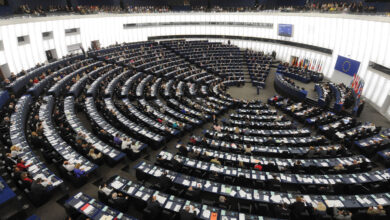Restructuring government departments

The announcement of the new Government heralded significant restructuring of government departments to reflect the allocations of functions to ministers. eolas explores the convention and legislative underpinning of this process.
Under Article 13 of Bunreacht na hÉireann, the Taoiseach is responsible for nominating the other members of the Government of Ireland for appointment by the President. Therefore, the Taoiseach is responsible for the allocation of functions between ministers of the Government. As such, the structure of departments of state can change, reflecting this allocation. While generally this occurs following a general election, it can take place at any time as per the Taoiseach’s instruction.
Therefore, in nominating the ministers of the Government, the Taoiseach indicates to Dáil Éireann any changes to ministerial functions and departmental structures. The power to transfer functions from one minister or department to another or to rename departments is legally underpinned by Section 6 of the Ministers and Secretaries (Amendment) Act 1939.
Specifically, a government may change the name or title of a minister or department (subsections 6 (1) (a) and 6 (1) (b)) or transfer functions from one minster or department to another via a Transfer of Functions Order (subsections 6 (1) (c) and 6 (1) (d)).
Departments which are entirely new and pre-existing departments which receive new responsibilities from counterpart departments are referred to as ‘receiving departments’. Meanwhile, departments whose responsibilities are being transferred to another department are called ‘transferring departments’.
By their nature, transfers of functions can vary in scale and complexity, especially when they entail the splitting of existing functions and decentralised offices. For example, if a transfer of functions impacts more than two departments, determining the staff to be transferred can be difficult.
Upon the Taoiseach’s announcement of changes in functions or in titles of departments, the Department of the Taoiseach is required to inform the relevant departments. Meanwhile, a senior official in the Department of Public Expenditure and Reform (DPER) is identified as the Central Coordinator for the implementation of a transfer of functions. The progress on and the timeliness of implementation of the structural or functional changes announced by the Government are overseen by the Civil Service Management Board (CSMB).
Transfer of Functions Order
The transfer of functions process should be concluded within eight weeks after the Taoiseach’s announcement in the Dáil. The announced changes do not take immediate effect. Instead, the effective date is determined by a statutory instrument (secondary legislation) signed by the Taoiseach, known as the Transfer of Functions Order.
Prepared by the transferring department, under Section 6 of the Ministerial and Secretaries (Amendment) Act 1939, a Transfer of Functions Order gives effect to transfers of functions. Within the Schedule to the Transfer of Functions Order “all acts, provisions of acts and regulations governing or impacting the functions being transferred” are comprehensively listed to ensure that all relevant functions are included in the order.
Progress on each order is coordinated by the DPER Central Coordinator. On instruction from a transferring department, the Office of the Parliamentary Council (OPC) drafts a Transfer of Functions Order. The OPC settles the final order before submitting a stamped copy to DPER. Where legal advice is required, for instance, if and when the requirement for primary legislation arises, the Office of the Attorney General can provide this.
For accounting purposes, using the existing department names, a transfer of functions order has an effective date from the beginning of the month proceeding the Taoiseach’s signature. The relevant Alteration of Title Orders are signed with an effective date of the day proceeding the Transfer of Functions Order.
Where there is discordance between the impacted departments, for example on the scope of functions to be transferred, the secretaries general of the respective departments are tasked with resolving differences.
Role of departments
Action 21 of the Civil Service Renewal Plan recommended that a “standardised approach” be developed for “the efficient reorganisation of departmental structures or functions when requested by the Government”. As such, DPER has drafted guidelines for each transfer of functions.
Both transferring and receiving departments affected by a transfer of functions must meet at the soonest opportunity to begin planning implementation of the changes. A transfer of functions should be led at secretary general level, with the transferring and receiving departments agreeing on the project lead. The secretary general in question must then nominate a member of their department’s management board to then oversee and drive implementation.
Simultaneously, an internal working group should be established within each transferring and receiving department, chaired by the secretary general’s management board nominee. During this process, the transferring department is required to supply the receiving department with timely information, including reference to existing budgetary and staffing.
|
Transfers of functions There are 10 established principles of transfers of functions. 1. Implementation should occur as soon as possible. 2. Departments should ensure that transfers are implemented efficiently. 3. Transfers should be Exchequer-neutral. 4. Transfers and their underpinning policy shape departments and require resources and, as such, efficiencies should be maximised. 5. Staff working on functions that are being transferred should move with them. 6. The finances and programme allocated to the functions that are being transferred should move with them. 7. The total staff and financial resources being transferred should be proportionate to the functions being transferred. 8. Records associated with the functions that are being transferred should move with them. 9. Property assets associated with the functions being transferred should move with them. 10. The National Shared Services Office should be consulted on services impacted by the transfer of functions. |
New departments
In a scenario where a receiving department is newly established, a number of unique challenges are presented. DPER guidelines emphasise the importance of a new or receiving department taking “effective, practical responsibility for policy, decisions and processes as soon as possible”.
It is recommended that an acting secretary general should be appointed to ensure that an incoming minister is immediately supported in beginning their work. This appointment is ideally made soon after the Taoiseach’s announcement, facilitating the interests and objectives of the new department from the outset of the transfer of functions process. The acting secretary general will then form a shadow senior management team with its members selected from the officials working in any of the pre-existing functions being transferred. A private secretary will also support the new minister in facilitating ministerial communications.
Once a government decides to establish a new department, under CSMB oversight, DPER and the Department of the Taoiseach are responsible for determining which staff from within the system be reassigned. As required, this includes finance, IT, accommodation, legal, HR and corporate function staff. Meanwhile, the Government Information Service is tasked with ensuring that a new department’s identity be developed within a system of unified visual identify.
32nd Government of Ireland
Delivering the Announcement of Government on 27 June 2020, An Taoiseach, Micheál Martin TD indicated “a major reconfiguration of central elements of how government is structured”. Not least, this includes the creation of the new Department of Further and Higher Education, Research, Innovation and Science as provided for by the Ministers and Secretaries and Ministerial, Parliamentary, Judicial and Court Offices (Amendment) Act 2020.
Likewise, Tánaiste Leo Varadkar TD now leads a restructured Department of Enterprise, Trade and Employment. “The transfer of Trade to the Department reflects the fact that the next few years will be unique in terms of the number and importance of trade issues will be decided,” the Taoiseach explained. Moreover, Eamon Ryan TD will lead “a major new portfolio” as Minister for Climate Action, Communication Networks and Transport.





